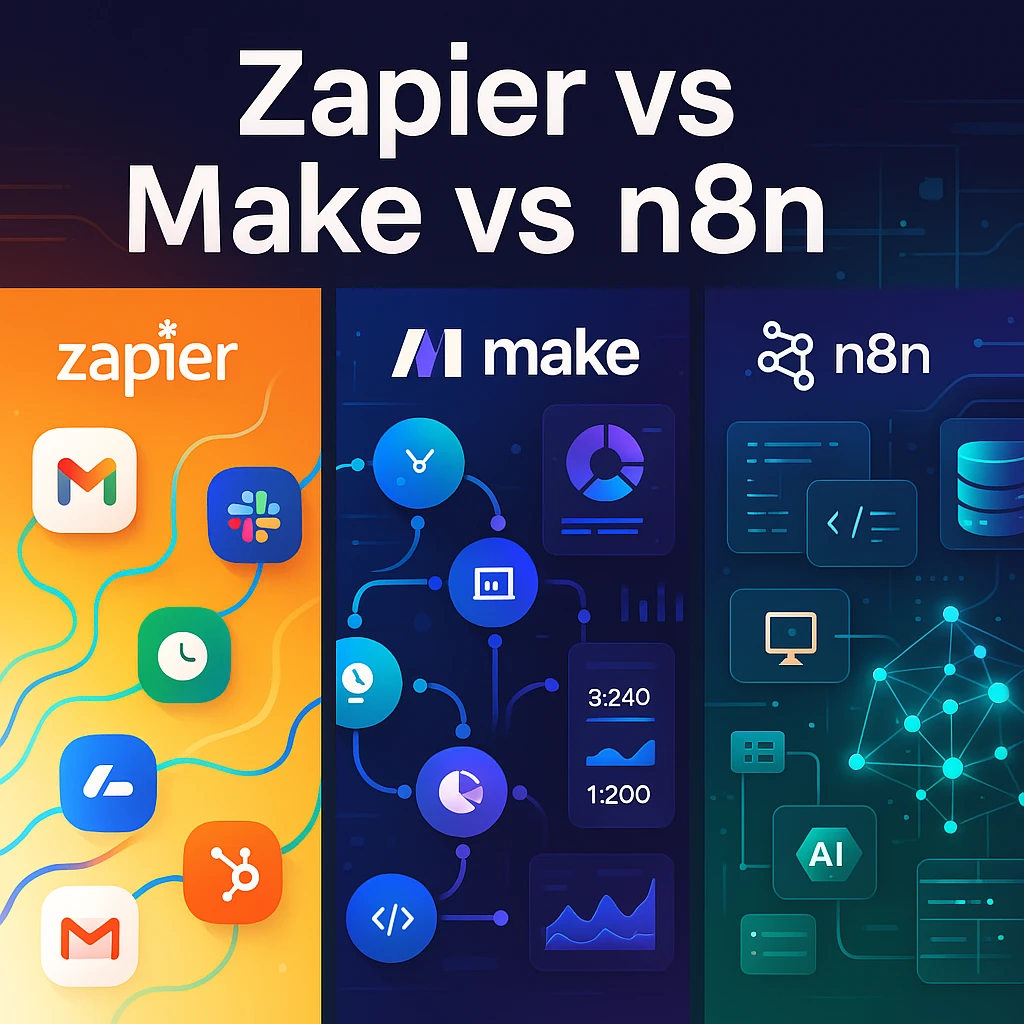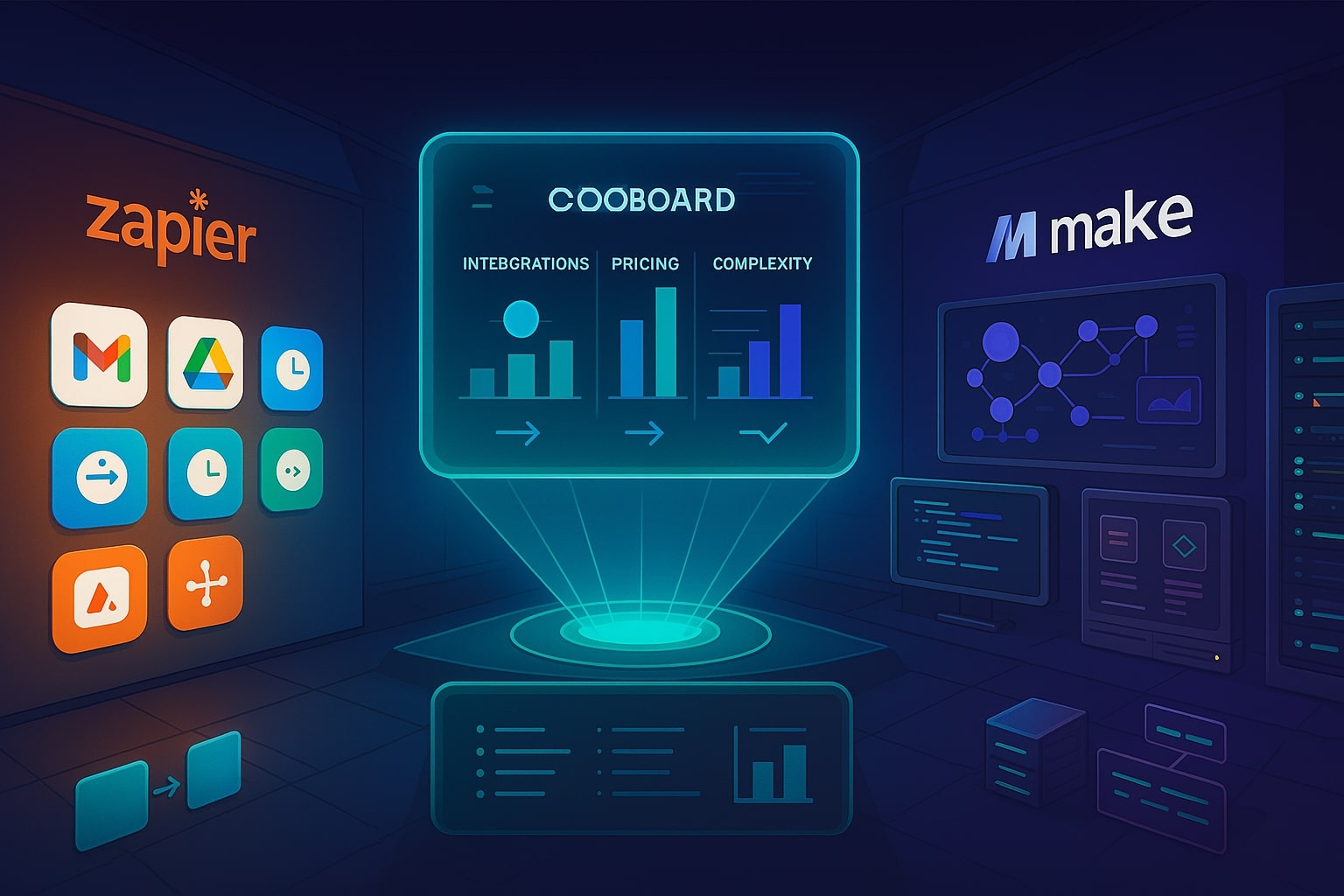Zapier: The Democratization Pioneer
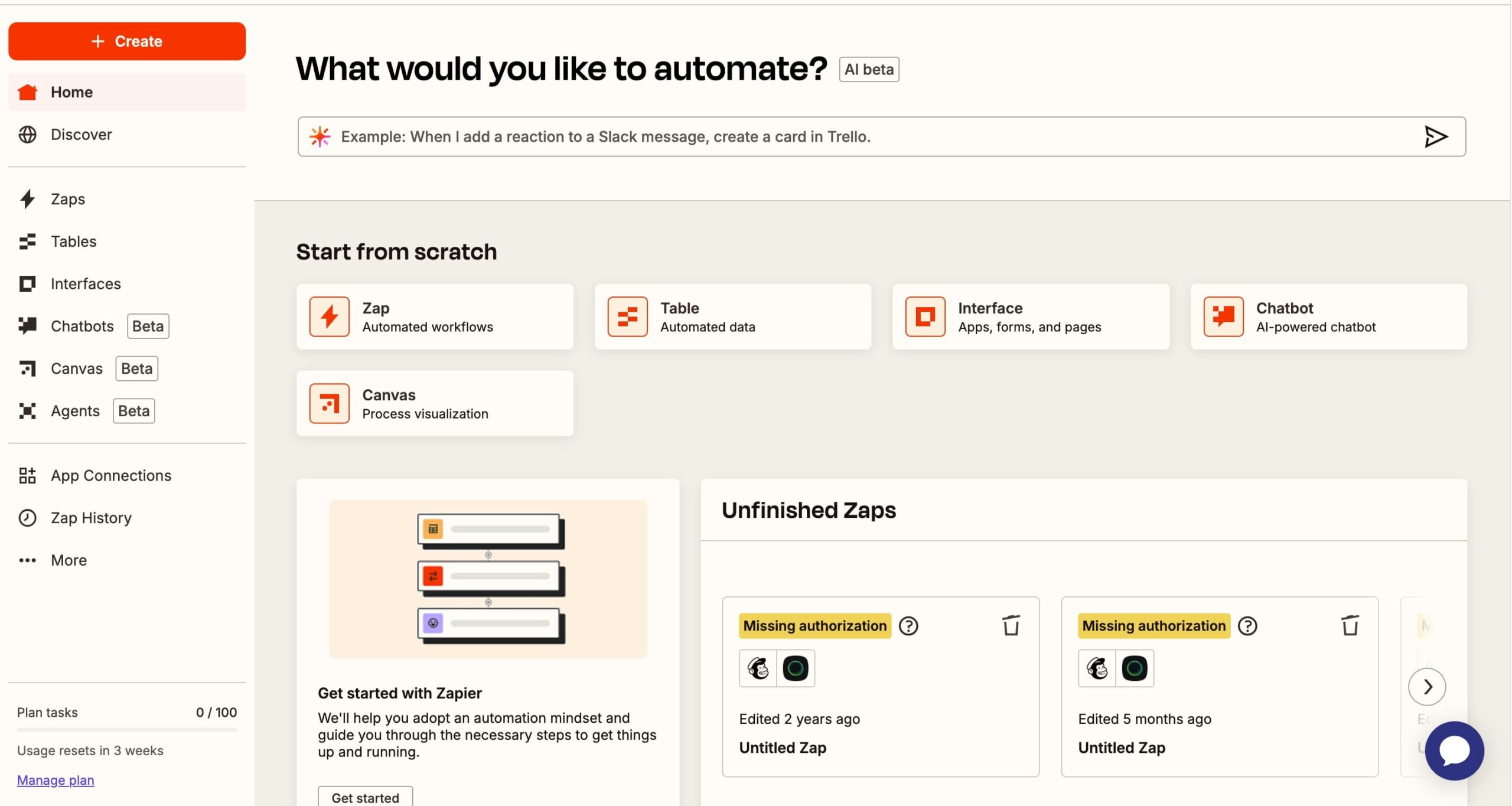
Since launching in 2011, Zapier established itself as the gold standard for no-code automation. Its mission remains clear: make automation accessible to everyone, regardless of technical background.
Core Strengths
Zapier’s primary advantage lies in its massive integration ecosystem. With over 7,000 pre-built connectors, it covers virtually every popular SaaS application plus countless niche services². This breadth means if your business uses mainstream tools like Salesforce, HubSpot, Slack, or Google Workspace, Zapier likely has native, well-maintained integrations ready to deploy.
The platform’s intuitive “Zap” creation process guides users through automation building with clear, step-by-step workflows. Non-technical team members can create functional automations within minutes, not hours. This accessibility has made Zapier the entry point for millions of users exploring automation for the first time.
AI Integration Approach
Zapier focuses on democratizing AI capabilities through simple, pre-configured nodes. Users can integrate ChatGPT, Claude, and other AI services without deep technical knowledge. However, this simplicity comes with customization limitations, you’re largely confined to predefined AI actions rather than building sophisticated AI workflows.
Pricing Reality Check
Zapier operates on a task-based pricing model that can become expensive quickly. The Starter plan costs $19.99/month for 750 tasks, with each action in your workflow counting as a separate task³. This means a simple 3-step automation processing 100 records consumes 300 tasks, nearly half your monthly allocation.
For businesses with high-volume operations, costs can escalate dramatically. Processing 10,000 tasks monthly could cost over $250, making Zapier one of the more expensive options for scale operations.
Where Zapier Excels
- Non-technical teams needing quick automation solutions
- Small businesses with straightforward integration needs
- Marketing departments automating lead nurturing and content distribution
- Sales teams requiring CRM synchronization across multiple platforms
Make: The Visual Workflow Architect
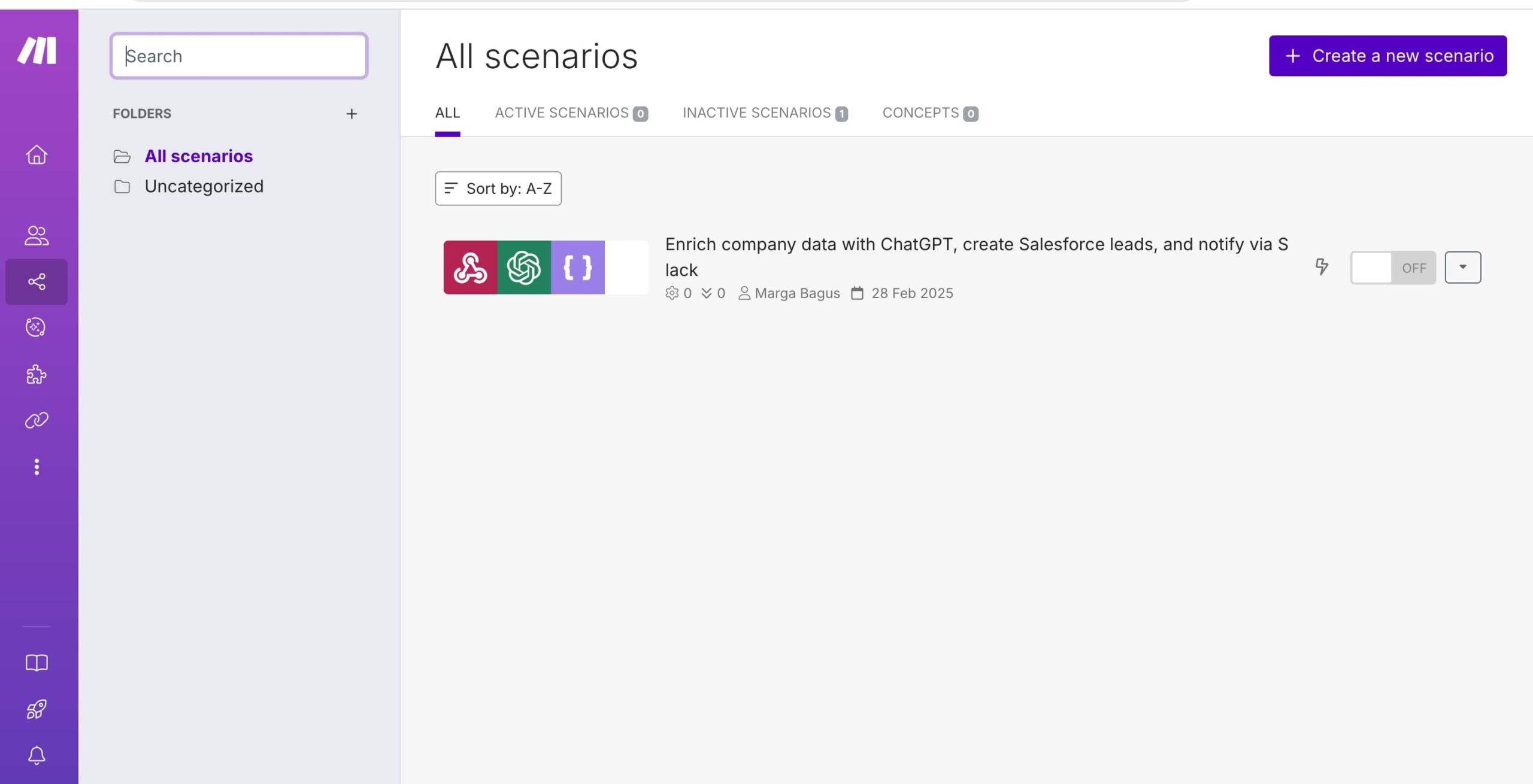
Make (formerly Integromat) positions itself as the strategic middle ground between Zapier’s simplicity and n8n’s technical depth. This European-based platform launched with a focus on visual workflow design and advanced error handling capabilities.
The Visual Advantage
Make’s standout feature is its sophisticated visual interface that displays data flow in real-time. Users can literally watch data move through their automations, making debugging and optimization significantly easier. This visual approach helps teams understand complex workflows at a glance—crucial for collaboration and maintenance.
The platform supports advanced workflow patterns including parallel processing, conditional routing, and data aggregation. Unlike Zapier’s linear approach, Make enables truly complex business logic with multiple triggers, converging paths, and sophisticated error handling.
Integration Ecosystem
With over 2,400 native integrations, Make offers fewer pre-built connectors than Zapier but compensates with superior customization options⁴. Each integration tends to be more comprehensive, offering deeper access to application APIs and more granular control over data handling.
Pricing Structure
Make charges per operation, similar to Zapier’s task model, but typically offers better value for complex workflows. Plans start at $9/month for 10,000 operations, making it significantly more affordable than Zapier for high-volume scenarios⁵.
The key difference lies in how operations are counted. Make’s router modules and error handlers don’t consume operations, allowing for more sophisticated logic without linear cost increases.
Where Make Dominates
- Marketing agencies managing complex client campaigns
- E-commerce businesses requiring sophisticated inventory and order management
- Project management teams coordinating across multiple platforms
- Data analysts needing robust ETL (Extract, Transform, Load) capabilities
n8n: The Open-Source Revolution
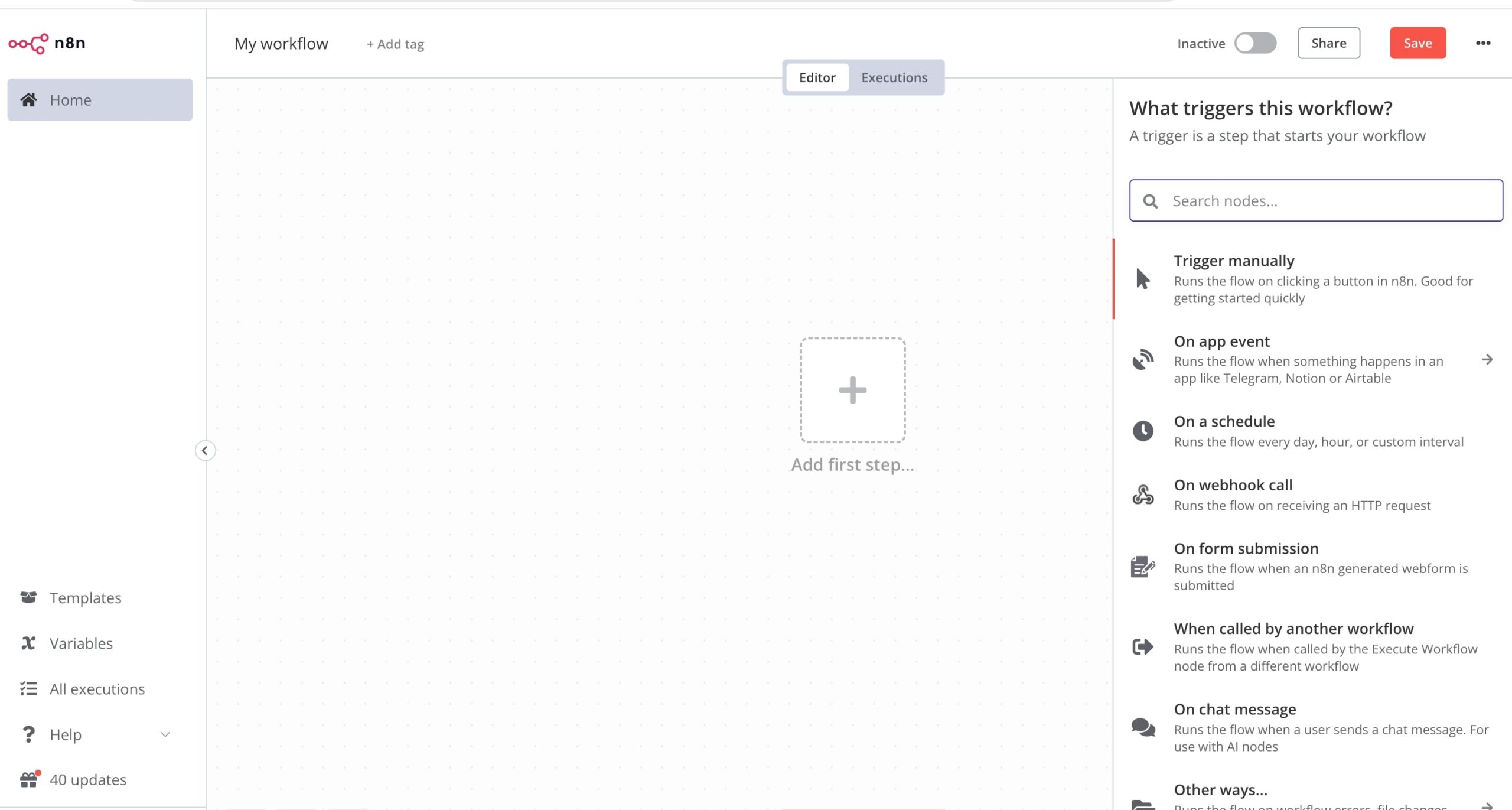
Launched in 2019, n8n represents a fundamental shift in automation philosophy. As an open-source, self-hostable platform, it offers unprecedented control over automation infrastructure while maintaining visual workflow design.
Technical Flexibility Unleashed
n8n’s node-based architecture enables complex workflow patterns impossible in traditional platforms. Users can implement custom JavaScript directly within workflows, create multiple triggers, build sophisticated conditional logic, and integrate with virtually any API through HTTP requests.
The platform excels at handling complex data transformations, implementing custom business logic, and creating truly intelligent automations. For technically skilled teams, n8n offers freedom to build exactly what they need rather than working within platform constraints.
AI-Native Capabilities
n8n positions itself as an AI-native platform with advanced LangChain integration and nearly 70 AI-specific nodes⁶. This technical approach enables sophisticated AI workflows like automated content generation, intelligent data analysis, and multi-model AI orchestration.
Unlike Zapier’s simplified AI approach, n8n allows deep customization of AI interactions, model switching, and complex prompt engineering—ideal for businesses building AI-powered products or services.
Cost Advantages
n8n’s pricing model fundamentally differs from competitors. Instead of charging per task or operation, n8n charges per complete workflow execution. This means a complex automation processing hundreds of data points costs the same as a simple two-step workflow.
The self-hosted option provides unlimited executions for the cost of server infrastructure—potentially reducing automation costs by 80-90% for high-volume operations⁷.
Security and Privacy Leadership
Self-hosting capabilities make n8n attractive for organizations with strict data governance requirements. Healthcare, finance, and government entities can maintain complete control over sensitive data while benefiting from powerful automation capabilities.
Where n8n Thrives
- Developers and technical teams building custom automation solutions
- Data-sensitive industries requiring on-premise deployment
- High-volume operations needing cost-effective scaling
- AI-focused businesses implementing sophisticated AI workflows
Plans & Pricing (August 2025)
Here’s a quick snapshot of publicly listed prices as of August 17, 2025. Use it to estimate first‑year costs and to sense how each billing unit (tasks, credits, executions) scales in the real world. Prices are shown at representative entry tiers; higher‑volume tiers scale accordingly.
| Platform |
Free plan |
Entry paid tier (annual billing) |
Team tier (annual billing) |
Billing unit |
| Zapier |
$0, 100 tasks/month |
Pro from $19.99/mo |
Team from $69/mo |
Tasks (per successful action) |
| Make |
$0, up to 1,000 credits/month |
Core $9/mo for 10,000 credits/month |
Teams $29/mo for 10,000 credits/month |
Credits (replace operations Aug 27, 2025) |
| n8n |
Community Edition (self‑hosted) free |
Starter $20/mo (annual) for 2.5K executions/month |
Pro $50/mo (annual) for 10K executions/month |
Executions (entire workflow run) |
Notes: Zapier also lists add‑on pricing for Agents (from $50/mo) and Chatbots/Interfaces/Tables (from $20/mo) at entry tiers. n8n Business starts at €667/mo (annual) for 40K executions self‑hosted; Enterprise is custom.
Pricing in Practice
Pricing is where teams feel the platform long after launch, so we modelled typical usage patterns and failure modes. Zapier rewards small, high‑signal workflows with crisp triggers, while chatty fan‑outs can spike task consumption if you don’t batch and debounce. Make’s credits are friendlier to AI‑heavy builds because consumption maps to what a module actually does, but you’ll want guardrails and dashboards so teams see dynamic credit modules early. n8n’s execution‑based billing is easiest to forecast when you compress steps into single runs and retry at the workflow level rather than action leve
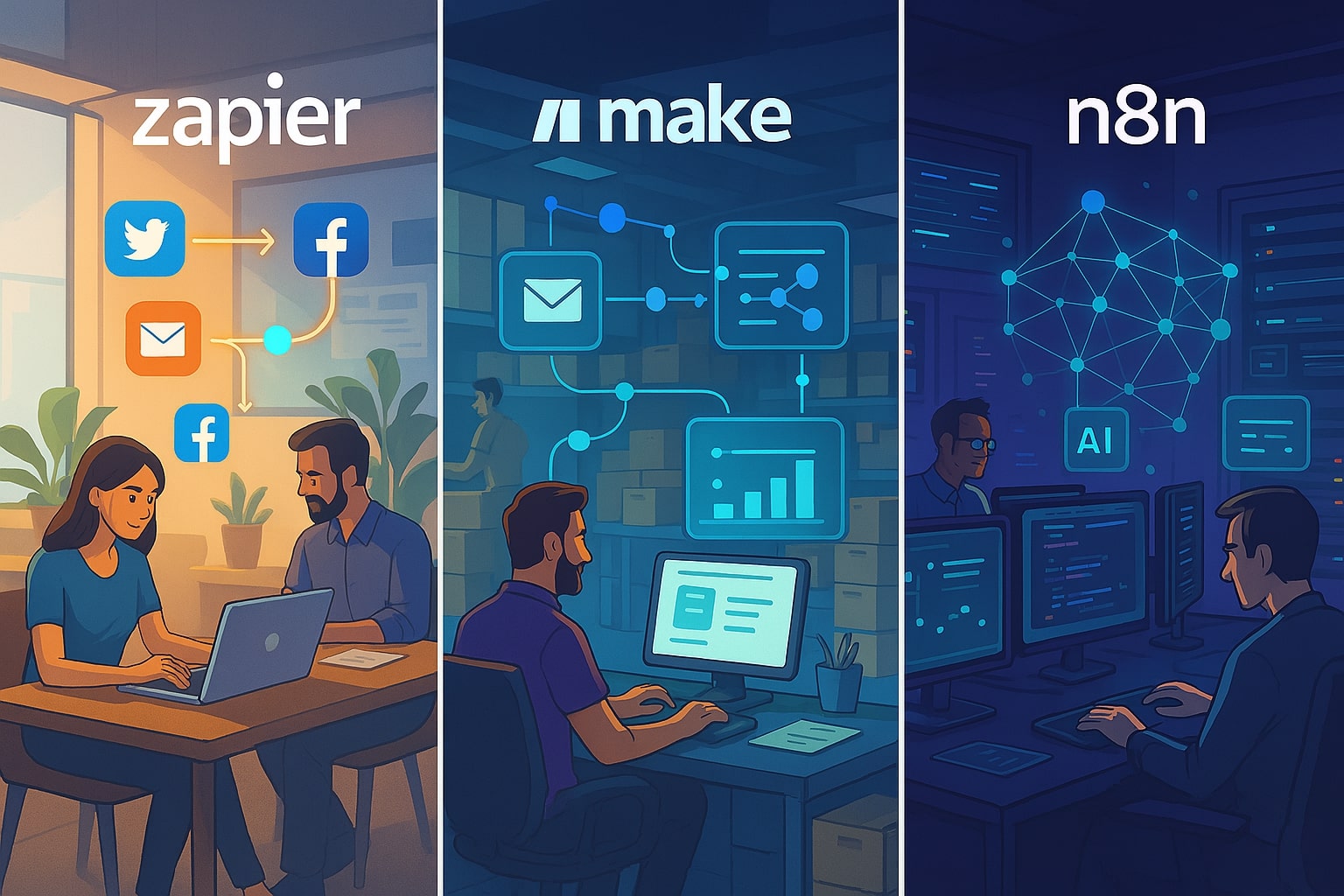
Use these scenarios to forecast total cost of ownership. We show the math transparently so you can swap your own volumes. Prices reflect public pages as of Aug 17, 2025 and exclude third‑party API/model costs (e.g., OpenAI tokens, Google API quotas).
Assumptions
- Workdays/month: 22.
- One run = one full workflow execution.
- Zapier: Tasks count successful actions (triggers don’t count). Overages switch to pay‑per‑task at 1.25× base task cost until you upgrade tiers.
- Make: Standard modules use 1 credit; some AI/advanced modules use dynamic credits (e.g., tokens, file size).
- n8n: One execution = one full workflow run, steps inside don’t affect quota.
Scenario A — Early‑stage GTM (lead capture → enrich → CRM → Slack)
- Volume: 50 leads/day → 1,100 runs/month.
- Shape: 4 actions/run (no AI).
- Consumption:
- Zapier: 4,400 tasks/month.
- Make: 4,400 credits/month.
- n8n: 1,100 executions/month.
Estimated monthly TCO (USD)
| Platform |
Subscription fit |
Est. subtotal |
Notes |
| Zapier |
Pro (annual) + task tier sized to ~4.4K tasks |
$19.99+/mo + task‑tier cost |
Add Agents $50/mo if used; Chatbots/Interfaces/Tables $20/mo each if used. |
| Make |
Core $9/mo covers 10K credits |
$9/mo |
Plenty of headroom; credits used ≈ 44% of tier. |
| n8n |
Starter $20/mo (2.5K exec) |
$20/mo |
Fits within quota; executions used ≈ 44% of tier. |
- Volume: 300 leads/day → 6,600 runs/month.
- Shape: 5 actions/run (no AI).
- Consumption:
- Zapier: 33,000 tasks/month.
- Make: 33,000 credits/month.
- n8n: 6,600 executions/month.
Estimated monthly TCO (USD)
| Platform |
Subscription fit |
Est. subtotal |
Notes |
| Zapier |
Pro/Team (annual) + task tier sized to ~33K tasks |
$69±/mo equivalent after task tier selection |
Use pricing slider to match volume; overages billed pay‑per‑task at 1.25× base task cost. |
| Make |
Illustrative: Core $9 / 10K credits → ~4 blocks |
≈$36/mo |
Assumes linear blocks; pick Teams $29/10K if you need collaboration features. |
| n8n |
Pro $50/mo (10K exec) |
$50/mo |
Fits in Pro; headroom ≈ 3.4K executions. |
Tip: On Zapier, reduce chatter with batches and Sequential Paths to lower task counts; on Make, consolidate modules; on n8n, keep more work inside a single execution.
Scenario C — AI‑heavy support triage (ingest → classify → LLM summary → CRM → Slack)
- Volume: 200 tickets/day → 4,400 runs/month.
- Shape: 3 standard actions + 2 AI actions/run.
- Consumption:
- Zapier: approximate 5 actions/run → 22,000 tasks/month (AI model usage billed by provider, not included).
- Make: 3 credits (standard) + ~20 dynamic credits (2 AI steps @ ~10 credits each) → ~23 credits/run → ≈101,200 credits/month.
- n8n: 4,400 executions/month (AI model usage external).
Estimated monthly TCO (USD)
| Platform |
Subscription fit |
Est. subtotal |
Notes |
| Zapier |
Pro/Team (annual) + task tier sized to ~22K tasks |
$69+ /mo equivalent after task tier selection |
Add‑ons: Agents $50/mo if agentic flows; Chatbots/Interfaces/Tables $20/mo each if used. |
| Make |
Blocks of 10K credits |
≈$99/mo (Core) to ≈$319/mo (Teams) |
Range shows Core $9/10K vs Teams $29/10K; exact spend depends on AI credit usage. |
| n8n |
Pro $50/mo (10K exec) |
$50/mo |
Within quota; add external LLM/token costs separately. |
DIY TCO Calculator (plug your numbers)
- Runs/month = events/day × 22 workdays.
- Zapier tasks = runs × actions/run (exclude triggers).
- Make credits (no AI) = runs × modules/run; with AI add dynamic credits per AI step.
- n8n executions = runs.
- Map the totals to the nearest plan on each pricing page, then add any Agents/Chatbots/Interfaces/Tables (Zapier) or extra credit blocks (Make). For n8n, ensure executions fit Starter or Pro; for larger volumes, consider Business (self‑hosted) and include infra costs.
Recommendations by Team Type
A clear pick is easier when you anchor to who will build and maintain the flows.
- Marketing, Sales, RevOps: choose Zapier for the smoothest UX, fast delivery, and predictable hand‑offs between non‑technical owners.
- Product, Ops Engineering, Data Ops: choose Make when you need reusable agents, heavy branching, and structured extraction from messy sources.
- Platform, Security‑sensitive Teams, Startups consolidating spend: choose n8n for self‑hosting, plugin freedom, and predictable costs by execution.
Review Roundup, Updated Scores (August 2025)
These editorial ratings reflect breadth, reliability, team readiness, and AI‑native workflows. They’re not about connector counts alone, they weight how confidently a platform survives rate limits, schema drift, and human error.
Zapier — 4.5/5
Why it wins: polished UX, mature governance, expanded Custom Actions, sequential Paths cut flakiness, Canvas accelerates planning.
Pros: broad catalog, fast build and publish, Canvas suggestions, strong admin controls.
Cons: task‑based billing can spike on chatty runs, no self‑hosted option.
Best for: business‑led automation, GTM teams, internal tools at non‑technical orgs.
Make — 4.4/5
Why it wins: agent‑centric architecture with context and MCP tooling, AI extractors reduce glue code, granular routing and rate control.
Pros: reusable agents across scenarios, grid‑like data work, rich routers.
Cons: credits introduce a new unit to learn, complex scenarios need discipline.
Best for: teams that mix makers and engineers, AI‑heavy automations, web data tasks.
n8n — 4.3/5
Why it wins: open‑core flexibility, execution‑based pricing, growing AI toolkit, strong self‑hosting story.
Pros: unlimited workflows, steps, users on paid tiers, custom and community nodes.
Cons: steeper learning curve for non‑developers, governance depends on your stack.
Best for: technical teams, security‑sensitive orgs, startups consolidating vendor spend.
Automation tools for small business: Practical Recommendations
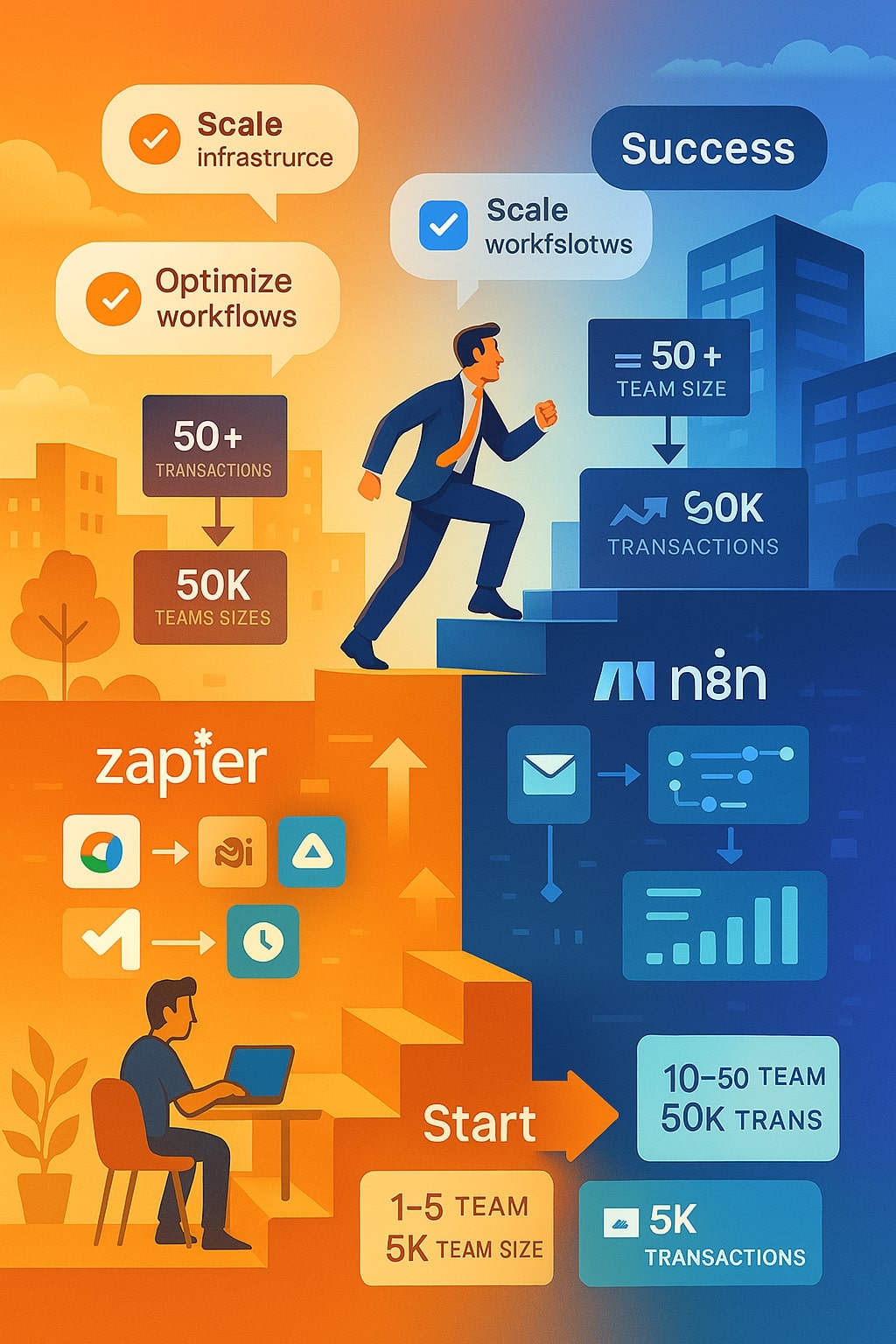
Illustration create with Microsoft Copilot.
For businesses just starting their automation journey, I recommend beginning with Zapier to understand basic automation concepts and identify high-impact use cases. Its extensive integration library and gentle learning curve make it ideal for proving automation value to stakeholders.
As automation needs grow more sophisticated, involving multiple conditional steps, complex data transformations, or custom business logic, Make provides an excellent upgrade path. Its visual design approach helps teams understand and maintain complex workflows while offering better cost efficiency than Zapier.
For technically capable teams or organizations with specific requirements around AI integration, data privacy, or cost optimization, n8n offers unmatched flexibility. However, success requires commitment to learning the platform and potentially managing infrastructure.
The Future of Workflow Automation

The automation landscape continues evolving rapidly, driven by AI advancement and increasing data privacy concerns. Platforms that successfully integrate sophisticated AI capabilities while maintaining security and cost-effectiveness will dominate the next phase of automation adoption.
Choose your automation champion based on your team’s technical capabilities, budget constraints, and long-term scalability needs. Remember, the best platform is the one your team will actually use effectively, not necessarily the one with the most features.
Need a second brain for setup or migration? I offer end‑to‑end services for auditing, designing, and implementing automations on Zapier, Make, and n8n—plus training so your team can run with it. Ready to scope your use cases, or want a quick teardown of your current stack? Contact me here, or tap the Let’s Chat button and tell me what you’re building.
Sources & References

